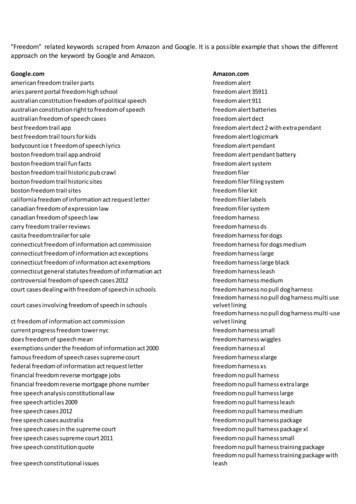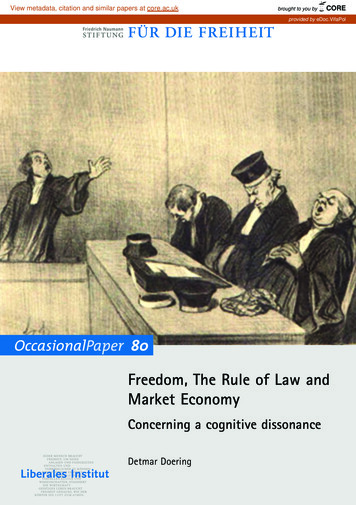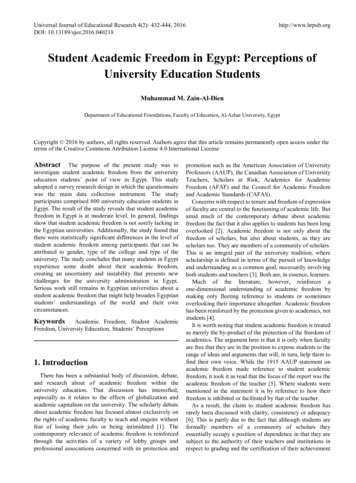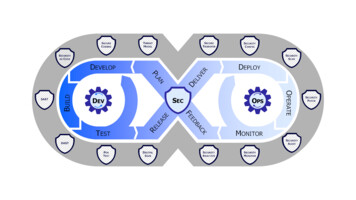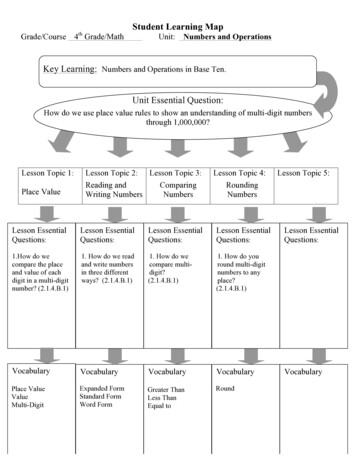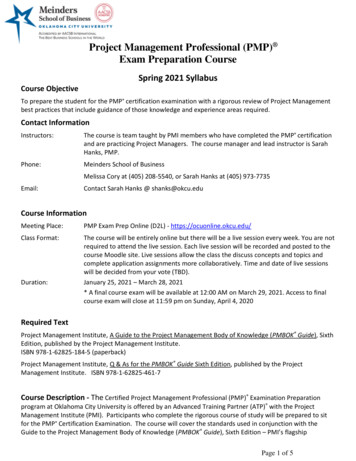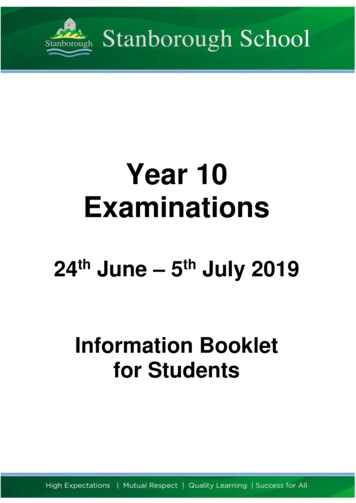
Transcription
GTI’MUN 21PNASTUDY GUIDETOPIC AREA A :Freedom and Rights of Minorities inPakistan
Introduction to the PNAPakistan National Assembly belongs to the lower house of the Pakistani Parliament.Its members are elected by the people of Pakistan through the voting system. ThePNA holds the responsible to look over the important decisions to be made onbehalf of the country, to ensure that the executives are working properly and thatnone of the rights of Pakistani citizens are being violated. This committee goesthrough options and potential ventures for the progress of Pakistan, they discusspasses or debates on bills, laws etc. PNA was founded in 1973. The NationalAssembly which is Pakistan's sovereign legislative body, makes laws for thefederation under powers spelled out in the federal legislative List and also forsubjects in the concurrent List, as given in the fourth schedule of the Constitution.Through its Debates, Adjournment Motion, Question hour and StandingCommittees, the National Assembly keeps check over the Executive and ensuresthat the government functions within the parameters set out in the Constitution anddo not violate the fundamental rights of citizens. Only the National Assembly(through its Public Accounts Committee) scrutinizes public spending and exercisescontrol of expenditure incurred by the government.
Introduction to the agendaThe Islamic Republic of Pakistan became an independent sovereign state on 14August 1947. Pakistan was formed with the aim to fulfil the right to selfdetermination of India’s Muslims, on the basis of a “two-nation theory” whichdescribed Hindus and Muslims as two different nations living in India. The creationof Pakistan meant carving out a state encompassing Muslim majority areas from thesubcontinent, which resulted in massive transfers of Hindu, Sikh and Muslimpopulations from areas where they were in the minority, often to provinces wherethey constituted a clear majority. When Pakistan was created its pluralisticcomposition was recognized by its founding fathers and also appears on its flag, thewhite patch in the Pakistani flag symbolizes the nation’s religious minoritycommunities. Mohammad Ali Jinnah one of the founding fathers of Pakistan andrecognized as Pakistan’s Quaid-e-Azam on the occasion of his first speech beforethe members of the Constituent Assembly of Pakistan in 1947, clearly declared thatnon-Muslims would be equal citizens in the new country and that every personliving in the country was an equal citizen irrespective of his or her community,caste, color or faith. In the 1970s, several elements culminated to contribute to arise in violent attacks against minority groups in Pakistan: a scramble for power byPakistan’s political parties led to even more instrumentalisation of religiousdivisions in society; the instrumentalization of discrimination of minorities intolegislation by the Islamist governments who came to power; and the militarizationof the region, with a proliferation of arms and trained fighters turning to violence tosettle conflicts. By the 1980s, violent sectarian attacks, especially targeting the Shiaand Ahmadi communities, became ever more commonplace. Among the attackstargeting Shias, those against the Hazaras in Balochistan are noteworthy. Theseattacks, which began during General Zia ul Haq’s regime in the 1980s, havecontinued over the subsequent decades, exacerbated by the proliferation of antiShia armed groups such as Lashkar-e-Jhangv, Al-Qaeda, and Tehrik-e-TalibanPakistan. Between January 2001 and October 2011, at least 386 violent murders ofHazaras were reported, and these attacks continue today.
On 10 January 2013, more than 100 Hazaras were killed and 121 injured in twinblasts in Quetta, the provincial capital of Balochistan. The attacks were supposedlycommitted by the Lashkar-e-Jhangv. The Ahmadi community in Pakistan is also atarget of violent attacks. The attacks against Ahmadis have escalated since the2000s when unknown men opened fire at an Ahmadi place of worship in a villagein Sialkot. One of the largest attacks targeting Ahmadis took place on 28 May 2010,when a coordinated attack on two Ahmadi places of worship by the Tehrik-eTaliban Pakistan killed over 80 people.
Discrimination of Minorities under the Constitution and the LawThe Constitution of Pakistan, in article 25 (1), guarantees that “all citizens are equalbefore law and are entitled to equal protection of law.” Article 5 provides that“adequate provision shall be made for the minorities to freely profess and practicetheir religions and develop their cultures,” and article 33 declares that it is thestate’s responsibility to discourage parochial, racial, tribal, sectarian, and provincialprejudices among citizens. However, these provisions have never been fullyimplemented in practice, and are contradicted by other provisions of theConstitution. Firstly, article 2 declares that “Islam shall be the State religion ofPakistan,” and article 31 states that it is the government’s duty to foster the Islamicway of life. Article 41(2) provides that “a person shall not be qualified for electionas President unless he is a Muslim,” and article 227 (1) states that “all existing lawsshall be brought in conformity with the Injunctions of Islam as laid down in theHoly Qur’an and Sunnah, in this Part referred to as the Injunctions of Islam, and nolaw shall be enacted which is repugnant to such Injunctions.” Even article 20 of theConstitution, which enshrines every citizen’s “right to profess, practice andpropagate his religion” and that “every religious denomination and every sectthereof shall have the right to establish, maintain and manage its religiousinstitutions”, is “subject to law, public order and morality,” and is thus contradictedin law and practice when it comes to the rights of religious minorities in Pakistan.Supposedly to prevent discrimination in employment in the public sector, a quotasystem was put in place during the regime of General Zia Ul Haq, reserving fivepercent of public sector jobs for minorities, and the other 95% of jobs being on thebasis of open merit including minority candidates. However, in practice this systemdoes little for affirmative action, and in fact exacerbates social discrimination andstereotypes against minorities. This is because many municipalities fill their fivepercent quota by employing only minorities in undesirable positions such assanitation workers. In some communities there have even been reports ofannouncements for such jobs indicating that Muslims need not apply. When thecountry of Pakistan was created, many non-Muslim communities left their homes inareas that were to become Pakistani territory to live in India. During this suddenexodus, they left behind many properties and land, including temples and places ofworship and land with religious symbolism. Soon after independence, a trust wasestablished under federal law, called the Evacuee Trust Property Board, to manage
the property, notably places of worship, that were left behind by non-Muslimcommunities. Although this Board is entrusted with the upkeep and protection ofsuch properties and does not have the right to sell any of these properties, much ofthe land under the Board’s control has been left uncared for, has been occupied,and/or sold. This is notably the case for properties belonging to the Hinducommunity. In Hyderabad alone, of the 350 temples and gurdawaras, only betweenfive to ten are privately managed, the rest were either occupied or have been sold.Only one temple is currently still maintained by the Evacuee Trust Property Board.In Sindh, most of the burial places that belonged to the Shudras and theuntouchables, have been taken over by Muslims, and Hindus belonging to lowercastes were not allowed to bury their dead there. The Evacuee Trust Property Boardhas evidently failed to fulfil its management and upkeep mandate, allowing manyplaces of worship to fall into disrepair and ignoring squatters on the land under theirpurvey. There have also been accusations of active collusion: the last Chair of theBoard, Mr. Asif Hashmi, is accused of having illegally sold property under theBoard’s control. The representation of minorities in assemblies in Pakistan remainsweak. While the National Assembly was reformed in 2002, increasing the totalnumber of seats to 342, the number of seats reserved for minority representativeswas not increased and remains at ten. A proposed constitution amendment bill wasmoved in the National Assembly in January 2014 seeking an increase in therepresentation of minorities in the national and provincial legislatures. However, inNovember the government rejected the proposal, claiming that such an increase ofseats reserved for minorities at the National Assembly, the Senate and theProvincial Assemblies was not possible until a new population census wasconducted.
Discrimination of Minorities in EducationDiscrimination prevails in the context of admissions to colleges and universities.Several higher education institutions implement a quota system that disadvantagesnon-Muslim students. For instance, at the Quaid-e-Azam University in Islamabad,each department may only enroll a total of two non-Muslim students. Even if a nonMuslim student achieves high enough scores to be admitted to the University, theyare refused admission if they fall beyond the quota, and the University will insteadadmit a Muslim student with a lower merit score. A newly launched report oneducation and inequality has found alarming levels of discrimination in educationalinstitutions based on religion, faith or belief. The report “Education and Inequality:Discerning the Foundation of Citizenry”, was organized by the SustainableDevelopment Policy Institute (SDPI) in Islamabad. The report was jointlyconducted by The Human Rights Commission of Pakistan (HRCP) and TheInstitute of Development Research and Corresponding Capabilities (IDRAC).The study was conducted in five districts of Punjab, including Bahawalpur, Multan,Khanewal, Nankana Sahib and Gujranwala, where around 200 non-Muslimstudents, 40 teachers and 40 parents were consulted to collect the data.The report showed that around 60 per cent of non-Muslim students experience orfeel that they are discriminated and disrespected, whereas, 70 per cent of the nonMuslim teachers faced discrimination on account of their faith. Similarly, 72% ofparents reported that their children were discriminated in educational institutions onaccount of their faith. In 2009, the UN Committee on the Rights of the Child notedwith concern reports of children of religious minorities having been restricted instudying and practicing their religion, and urged the government of Pakistan toensure that children have the choice whether or not to participate in religiouseducation classes. The committee also condemned the “persistence ofdiscriminatory societal attitudes and discrimination against children belonging to[inter alia] a religious group” in Pakistan, and issued several recommendations tothe Pakistani authorities to address this problem. To date, these issues still persistand the government has yet to implement the Committee’s recommendations.
Other issues of concern1.Lack of recognition in the national censusThe most recent census of the Pakistani population dates back to 1998. It states that96.28 percent of Pakistanis are Muslims, 1.59 percent Christians, 1.6 percentHindus, 0.25 percent Ahmadis, 0.25 percent are from the scheduled castes and 0.07are described as “others”. Minority representatives refute these numbers and in theabsence of a recent census, it is unclear whether the size of the different minoritygroups has grown or dwindled. A national census weighs particular importance as itensures that minority population is not under-counted within development schemes,government initiatives, and through proportional quota and representation systemsin different government institutions. Moreover, representatives from minoritycommunities take issue with the use of the term “others” to lump togethercommunities that do not fall within the 5 main religious categories.2.Further discrimination against AhmadisThe discrimination against Ahmadis is enforced through public policies limitingtheir access to education, professional opportunities, and basic political and civilrights. For example, when filling out the application form for a Pakistani passport,anyone who mentions his religion as Islam is asked to pledge that she or he is notan Ahmadi, or risk being charged under section 298-C of the PPC. Ahmadis are notallowed to have public places of worship, and are thus confined to their homes fortheir religious ceremonies. The official Ahmadi newspaper, which is only allowedto circulate among paid subscribers, does not have the right to promote the Ahmadifaith, be it directly or indirectly.
3.Forced and coerced marriageForced marriages of girls take place under majority religious law which deemspuberty as a license for marriage. In 2013, the UN Committee on the Elimination ofDiscrimination against Women denounced the persistence of forced marriages andforced conversions in Pakistan and the continued use of religious law to justify suchcrimes.21 While in Muslim law the consent of parents or a wali (guardian) of thebride (whether minor or not) is taken otherwise the marriage remains unrecognized,the same principle does not apply when a Hindu girl is being converted and marriedto a Muslim man, so many Muslim men seek out young Hindu girls to forciblyconvert and marry, as they legally need not bother with getting the girl’s guardian’sconsent or permission. Court rulings have supported such discrimination, notablylegally recognizing the apparently coerced conversion of a seven year-old Hindugirl to Islam, or by legally dissolving a married Hindu woman’s first marriage to aHindu man so that she can be forcibly wed to a Muslim man. The societaldiscrimination is such that the media has published positive stories on Christiangirls converting to Islam and marrying Muslim men, when at the same time reportshave been received of mobs of Muslims attacking Christian homes simply becausea Christian man is courting a Muslim woman.
The impact of COVID 19 on Minorities in PakistanRecently, as the COVID-19 pandemic has diverted the world’s attention, cases ofdiscrimination against minorities have risen significantly. Several incidents havebeen reported in which Christians and Hindus were denied food rations. Christiansform a sizable portion of frontline workers in Pakistan, and they are at a high risk ofcontracting the virus because they are not endowed with the protective kits that areconsidered essential by health experts. At a time when being at home for “socialdistancing” is of paramount importance for both individual and collective health,there have even been reports of Hindu houses in Punjab being demolished.In a press release the USCIRF noted the denial of coronavirus-related food aid toreligious minorities and described these actions as “simply reprehensible.” Ithighlighted the case of the Karachi-based Saylani Welfare International Trust,which denied food aid to Hindu and Christian homeless and seasonal workers onthe grounds that such aid was reserved only for members of the Muslimcommunity. Facing continuous backlash from human rights groups, Pakistan hasmade some efforts to remedy the situation. The establishment of the NationalMinority Commission in May 2020 was perhaps the most important of these, butthis too has been dubbed a half-hearted effort by many. First, the body was notestablished through parliamentary legislation, as Pakistan Supreme Courtguidelines recommend. The action was instead taken through a cabinet decision,which deprives the commission of any power to actually enforce its edicts.Secondly, and most importantly, the Ahmadiyyas who are among the mostpersecuted minorities in Pakistan have been denied a seat at the table. Excludingthem casts doubt over the legitimacy of the commission. Another recent step wasthe 2019 establishment of the Kartarpur corridor to make it easier for Sikhs fromboth India and Pakistan to access the holy site of Darbar Sahib. Although it wasdemanded for years, this move does little to solve the issues faced by Sikhs on adaily basis. The Pakistani government has also undertaken the renovation of someHindu temples. But is renovating temples really a step forward if a greater numberare razed each day than refurbished? In lieu of thoroughly addressing the problemsfaced by minorities, the government’s solutions amount to just posturing.
Questions the Committee must answer1.How should the constitution of Pakistan be changed in order for it to be morebeneficial for the minorities?2.How successful has the government of Pakistan been in educating its peopleregarding the rights of minorities?3.Why have the proposed solutions to this issue not been properly implementedby the government?4.What solutions is your party proposing in order to end marginalization againstminorities and how will you implement them?
itc/mealac/pritchett/00islamlinks/txt jinnah assembly /05/30/world/asia/30pstan.html? r 1&http://tbinternet.ohchr.org/ layouts/treatybodyexternal/Download.aspx?symbolno CERD%2fC%2fPAK%2fCO%2f20&Lang 51b9a0794.htmlhttp://tbinternet.ohchr.org/ layouts/treatybodyexternal/Download.aspx?symbolno CEDAW%2fC%2fPAK%2fCO%2f4&Lang ontent/pdf/ff/5.pdf
STUDY GUIDE. TOPIC AREA A : Freedom and Rights of Minorities in Pakistan. . (HRCP) and The Institute of Development Research and Corresponding Capabilities (IDRAC). The study was conducted in five districts of Punjab, including Bahawalpur, Multan, Khanewal, Nankana Sahib and Gujranwala, where around 200 non-Muslim .
